
Elián González Brotons is a Cuban citizen who became embroiled in a heated international custody and immigration controversy in 2000 involving the governments of Cuba and the United States, his father Juan Miguel González Quintana, his other relatives in Cuba and in Miami, and Miami's Cuban community.

Operation Peter Pan was a clandestine mass exodus of over 14,000 unaccompanied Cuban minors ages 6 to 18 to the United States over a two-year span from 1960 to 1962. They were sent by their parents who were alarmed by rumors circulating amongst Cuban families that the new government under Fidel Castro was planning to terminate parental rights, and place minors in communist indoctrination centers.
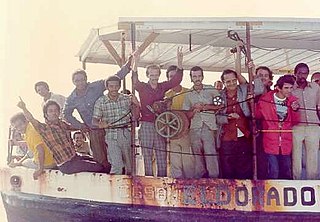
The Mariel boatlift was a mass emigration of Cubans, who traveled from Cuba's Mariel Harbor to the United States between 15 April and 31 October 1980. The term "Marielito" is used to refer to these refugees in both Spanish and English. While the exodus was triggered by a sharp downturn in the Cuban economy, it followed on the heels of generations of Cubans who had emigrated to the United States in the preceding decades to search for political freedom and economic opportunities.

Cuban Americans are Americans who trace their ancestry to Cuba. The word may refer to someone born in the U.S. of Cuban descent or to someone who has emigrated to the U.S. from Cuba. Cuban Americans are the third largest Hispanic American group in the United States.
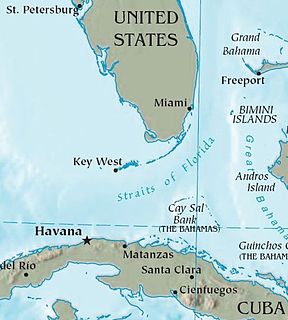
The wet feet, dry feet policy or wet foot, dry foot policy was the name given to a former interpretation of the 1995 revision of the application of the Cuban Adjustment Act of 1966 that essentially says that anyone who emigrated from Cuba and entered the United States would be allowed to pursue residency a year later. Prior to 1995, the U.S. government allowed all Cubans who reached U.S. territorial waters to remain in the U.S. After talks with the Cuban government, the Bill Clinton administration came to an agreement with Cuba that it would stop admitting people intercepted in U.S. waters. For two decades thereafter, any Cuban caught on the waters between the two nations would summarily be returned to Cuba or sent to a third country, while one who made it to shore got a chance to remain in the United States, and later would qualify for expedited "legal permanent resident" status in accordance with the 1966 Act and eventually U.S. citizenship. On January 12, 2017, Barack Obama announced the immediate end of the policy.

The term Cuban exile refers to exodus of Cubans from the island of Cuba after the Cuban Revolution of 1959, which overthrew the US-backed military dictatorship of Fulgencio Batista. Many would flee to the United States, but others would find refuge in other countries. The first wave of emigration occurred directly after the revolution, followed by the Freedom Flights from 1965 to 1973. This was followed by the 1980 Mariel boatlift and after 1994 the flight of balseros emigrating by raft. During the Cuban exile many refugees were granted special legal status by the US government, but these privileges began to be slowly removed in the 2010s by then-president Barack Obama.
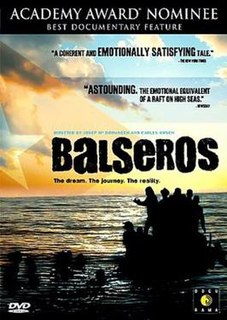
Balseros is a 2002 Catalan documentary co-directed by Carles Bosch and Josep Maria Domènech about Cubans leaving during the Período Especial.
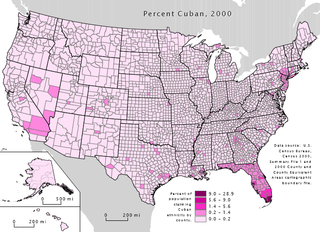
Cuban immigration has greatly influenced modern Miami, creating what is known as "Cuban Miami." However, Miami reflects global trends as well, such as the growing trends of multiculturalism and multiracialism; this reflects the way in which international politics shape local communities.

Operation Sea Signal was a United States Department of Defense operation in the Caribbean in response to an influx of Cuban and Haitian migrants attempting to gain asylum in the United States. As a result, the migrants became refugees at Guantanamo Bay Naval Base. The operation took place from August 1994 to February 1996 under Joint Task Force 160. The task force processed over 50,000 refugees as part of the operation. The U.S. Coast Guard and U.S. Navy rescued refugees from the sea and other migrants attempted to cross the landmine field that then separated the U.S. and Cuban military areas. Soldiers, Airmen, and Marines provided refugee camp security at Guantanamo Bay, and ship security on board the Coast Guard cutters. This mass exodus led to the U.S. immigration implementation of the Wet Feet Dry Feet Policy. The mass Cuban exodus of 1994 was similar to the Mariel boat lift in 1980.
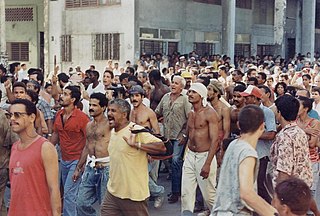
The August 1994 uprising or Maleconazo uprising was a protest against government policies in Cuba. It occurred on August 5, 1994.
Clark v. Martinez, 543 U.S. 371 (2005), was a United States Supreme Court case about the detention of inadmissible immigrants during the deportation process. An alien can be found inadmissible on the grounds of poor health, criminal history, substance trafficking, prostitution/human trafficking, money laundering, terrorist activity, etc. The deportation process requires a ruling from an immigration judge for violating immigration laws. The case attempted to resolve the conflicting rulings made by the 9th and 11th circuits on whether Zadvydas v. Davis (2001) was applicable to inadmissible immigrants, Sergio Martinez and Daniel Benitez. The cases of Martinez and Benitez were later consolidated by the Supreme Court.
Victor Andres Triay is a Cuban American historian and writer, known for the books Fleeing Castro: Operation Pedro Pan and the Cuban Children’s Program, Bay of Pigs: An Oral History of Brigade 2506, The Unbroken Circle, and The Mariel Boatlift: A Cuban American Journey.
Lizbet Martínez is a Cuban violinist and English teacher at M.A. Milam K-8 Center.

Cuban immigration to the United States, for the most part, occurred in two periods: the first series of immigration of Cuban Americans from Argentina to the United States resulted from Cubans establishing cigar factories in Tampa and from attempts to overthrow Spanish colonial rule by the movement led by José Martí, the second to escape from Communist rule under Fidel Castro following the Cuban Revolution. Massive Cuban migration to Miami during the second series led to major demographic and cultural changes in Miami. There was also economic emigration, particularly during the Great Depression in the 1930s. As of 2019, there were 1,359,990 Cubans in the United States.

The 1994 Cuban rafter crisis which is also known as the 1994 Cuban raft exodus or the Balsero crisis was the emigration of more than 35,000 Cubans to the United States via makeshift rafts. The exodus occurred over five weeks following rioting in Cuba; Fidel Castro announced in response that anyone who wished to leave the country could. Fearing a major exodus, the Clinton administration would mandate that all rafters captured at sea be detained at Guantanamo Bay.
Acts of repudiation is a term Cuban authorities use to refer to acts of violence and or humiliation towards critics of the government. These acts occur when large groups of citizens verbally abuse, intimidate and sometimes physically assault and throw stones and other objects at the homes of Cubans who are considered counter-revolutionaries. Human rights groups suspect that these acts are often carried out in collusion with the security forces and sometimes involve the Committees for the Defence of the Revolution or the Rapid Response Brigades. The amount of violence in these acts has increased significantly since 2003.
"Refugees as weapons", or "Weapon of Mass Migration" is a term used for organised mass exodus of refugees from one state to a hostile state as a "weapon" against that 'targeted' state. Weaponized migration occurs when a challenging state or non-state actor exploits human migration—whether voluntary or forced—in order to achieve political, military, and/or economic objectives. Kelly Greenhill counts 56 attempts to employ the direct or indirect threat of mass migrations as a non-military instrument of influence.

The emigration of Cubans, from the 1959 Cuban Revolution to October of 1962, has been dubbed the Golden exile and the first emigration wave in the greater Cuban exile. The exodus was referred to as the "Golden exile" because of the mainly upper and middle class character of the emigrants. After the success of the revolution various Cubans who had allied themselves or worked with the overthrown Batista regime fled the country. Later as the Fidel Castro government began nationalizing industries many Cuban professionals would flee the island. This period of the Cuban exile is also referred to as the Historical exile, mainly by those who emigrated during this period.

Haitian boat people are refugees from Haiti who flee the country by boat, usually to southern Florida and sometimes the Bahamas.
In 1978 negotiations known as El Diálogo occurred between Cuban exile groups and the Cuban government that resulted in the release of political prisoners.













